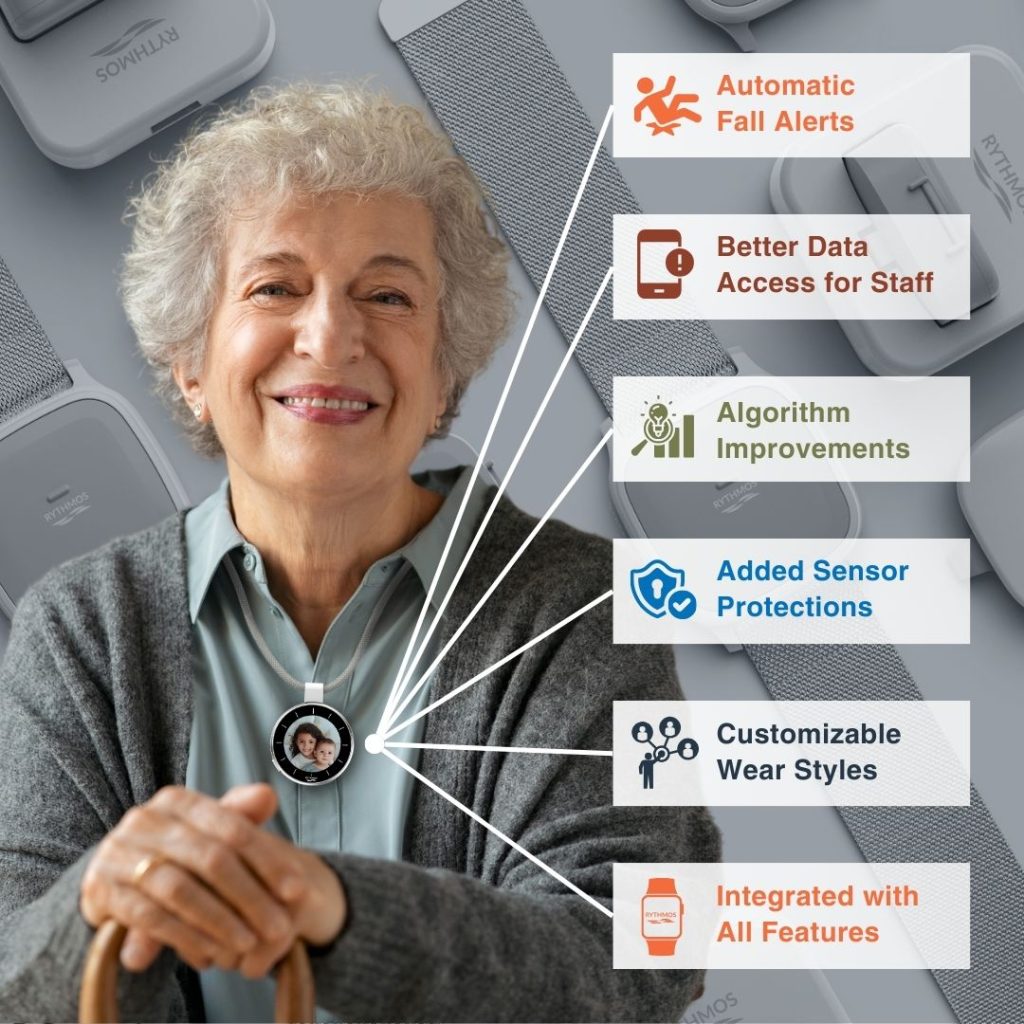While it’s true that the risk of falling tends to rise as individuals grow older, senior falls should not be seen as an inevitable outcome of getting older.
Senior falls have emerged as a significant concern with far-reaching consequences. Beyond the immediate physical and emotional toll, falls among older adults also carry significant financial implications for individuals, families, healthcare systems, and more. In today’s senior living communities, falls pose significant risks beyond physical harm, including legal and financial implications. Falls can lead to lawsuits alleging negligence, resulting in substantial legal fees, compensation, and reputational damage.
However, it’s essential to remember that there are solutions and technologies available to help prevent falls, such as fall detection wearable devices like Rythmos®, designed to improve the quality of life of seniors and ease of care.

The Importance of Fall Prevention for Senior Falls
According to data from the Centers for Disease Control and Prevention (CDC) and the National Council on Aging (NCOA), fall prevention is a major concern in the senior community. Check out these eye-opening statistics:
Factors Contributing to Senior Falls
Several factors contribute to the increased risk of falls among seniors:
Physical Changes
As individuals age, they experience declines in muscle strength, balance, and flexibility, making them more susceptible to falls.
Chronic Health Conditions
Conditions like arthritis, Parkinson’s disease, diabetes, and sensory impairments can increase the risk of falls among seniors.
Medications
Certain medications, especially those that affect blood pressure or cause dizziness or drowsiness, can contribute to falls.
Environmental Hazards
Cluttered living spaces, poor lighting, uneven flooring, slippery surfaces, and lack of handrails or grab bars can create hazards that increase the risk of falls.
The Cost of Senior Falls: Beyond the Physical Toll
The financial toll of falls among seniors can be staggering. Annually, approximately $754 million is expended on fatal falls, as reported by the CDC. Additionally, when significant injuries occur due to serious falls, medical costs alone amount to a whopping $50 billion each year. Medicare covers $29 billion of this amount, while $12 billion is attributed to private insurance or out-of-pocket payments, and Medicaid contributes $9 billion.
According to McKnight’s Senior Living,
“Across assisted living communities and skilled nursing facilities, the annual direct cost of all falls was $380,000 per location. For providers with 20 or more locations, the average cost was $712,000, and for providers with 19 or fewer facilities, the cost was $158,000 per location.”
The impact of falls extends beyond immediate medical expenses and includes:


Investing in Fall Prevention with Rythmos®
By offering a comprehensive suite of features tailored to address the unique needs of senior living communities, Rythmos® represents a paradigm shift in fall prevention and senior care management. Through real-time monitoring, advanced machine-learning fall detection, and personalized support, Rythmos® fall detection wearable devices empower seniors to maintain their independence while providing caregivers and families with peace of mind.
As we navigate the complex landscape of senior falls, Rythmos® stands as a testament to the power of innovation in safeguarding the health, safety, and dignity of our aging population.
Integrated Customized Fall Detection
Rythmos® brings next-generation fall detection to reduce false alarms while increasing the accuracy of detecting real falls. Utilizing advanced tools including machine learning and AI to continuously improve the fall detection algorithm in real-time for each individual resident ensuring the highest degree of fall detection accuracy.
The Rythmos® suite not only enhances senior care staff response times but also offers reassurance to family members. With its advanced features, including fall detection, real-time location tracking, and data-driven insights on activity levels and behavioral changes, our wearables serve as a proactive tool to identify potential issues and the need for an elevated level of care.
Rythmos® wearables include the following:
Have Questions? Let’s Talk!
If you’re interested in buying the most advanced wearable with fall detection for seniors or want to learn more about our Rythmos® wearables and senior community solutions, please contact us.
Our team at Intrex is dedicated to improving care for your loved ones and assisting seniors and caregivers with efficient, scalable, and affordable tech solutions. Let us know how we can help!

